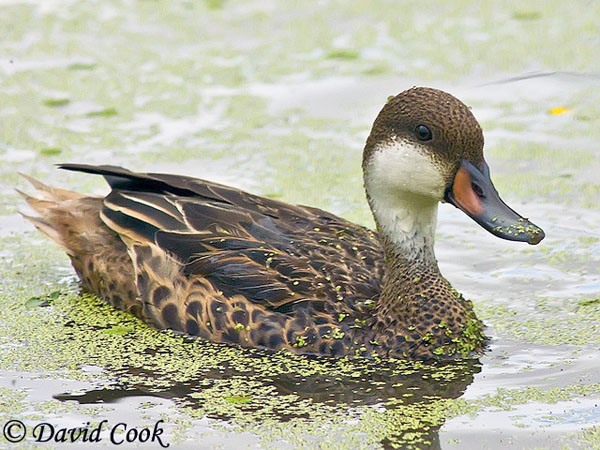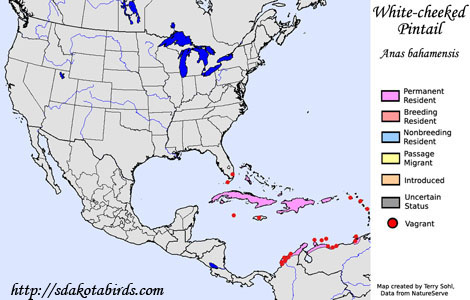| Length: 16-18 inches | Wingspan: 26-28 inches | Seasonality: Non-resident in South Dakota |
| ID Keys: Dark brown overall, white cheeks and foreneck, two-toned orange and black bill. Females and males similar. | ||
 The
White-cheeked Pintail is a bird of the tropical Americas, found in South
America and the Caribbean. Occasional sightings of the species occur
in Florida. Sightings also have occurred elsewhere in the United
States, but these are likely escapees from captivity, as the White-cheeked
Pintail is sometimes kept as a domestic bird. They are also sometimes
referred to as the "Bahama Duck" or "Bahama Pintail", and the sub-species
endemic on the Galapagos Islands is sometimes called the "Galapagos
Pintail".
The
White-cheeked Pintail is a bird of the tropical Americas, found in South
America and the Caribbean. Occasional sightings of the species occur
in Florida. Sightings also have occurred elsewhere in the United
States, but these are likely escapees from captivity, as the White-cheeked
Pintail is sometimes kept as a domestic bird. They are also sometimes
referred to as the "Bahama Duck" or "Bahama Pintail", and the sub-species
endemic on the Galapagos Islands is sometimes called the "Galapagos
Pintail".
Habitat: Found primarily in coastal areas, using brackish water more than most dabbling ducks. Habitats include mangrove swamps, coastal estuaries, and saline ponds and lakes. Will use freshwater lakes as well, but is less common on those habitats, resulting in a population distribution skewed towards coastal areas.
Diet: Plant matter makes up a majority of the diet, including the seeds, roots, shoots, and leaves of aquatic plants, as well as grasses and sedges. They will also feed on aquatic insects and their larvae, snails, and small mollusks and crustaceans.
Behavior: A dabbling duck, feeding by dabbling at the water's surface, or upending with the head under water.
Nesting: The nest of a White-cheeked Pintail is a depression scraped in the ground, lined with grasses and down, typically placed near or under a clump of vegetation. The female alone incubates the eggs, and tends to the young after hatching.
Song: Males make a whistling sound, while females have a quack.
Migration: Considered a permanent resident throughout much of their range, although some populations are short-distance migrants.
Interactive eBird map: Click here to access an interactive eBird map of White-cheeked Pintail sightings
Similar Species: Distinctive if seen well
Conservation Status: There are no major threats to global White-cheeked Pintail populations, and the IUCN considers them a species of "Least Concern". However, hunting and habitat destruction have resulted in declines in the species from historical levels.
Further Information: 1) Cornell's Neotropical Birds - White-cheeked Pintail
2) ARKIVE - White-cheeked Pintail
3) BirdLife International - White-cheeked Pintail
Photo Information: Photo taken by David Cook - July 23rd, 2008 - Santa Cruz Island, Galapagos - licensed under Creative Commons Attribution Non-Commercial2.0 Generic License
| Click below for a higher-resolution map |
 |
| South Dakota Status: Non-resident in South Dakota |
Additional White-cheeked Pintail Photos (coming soon!!)
